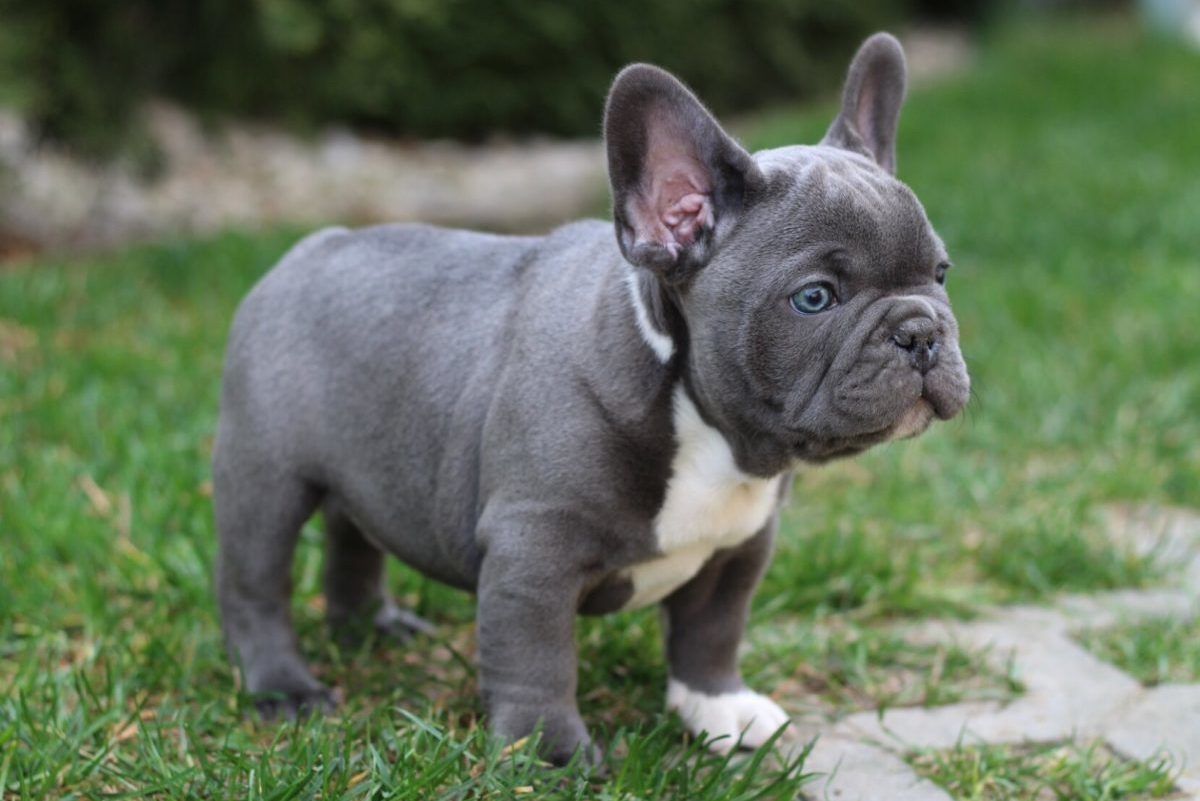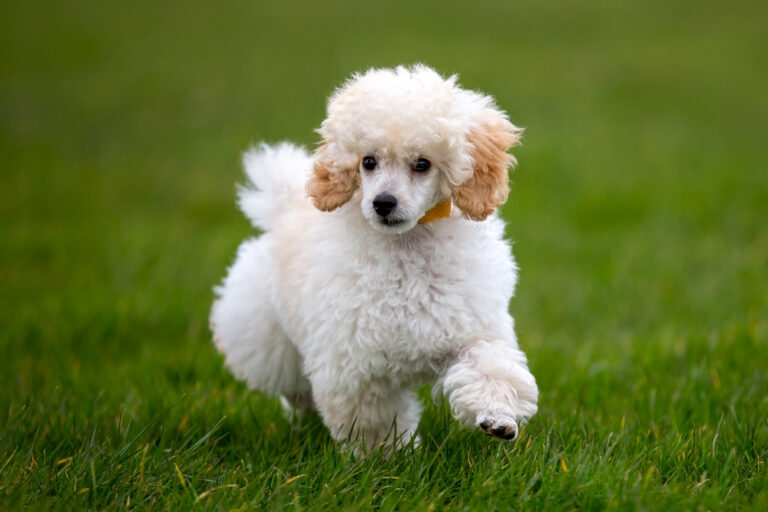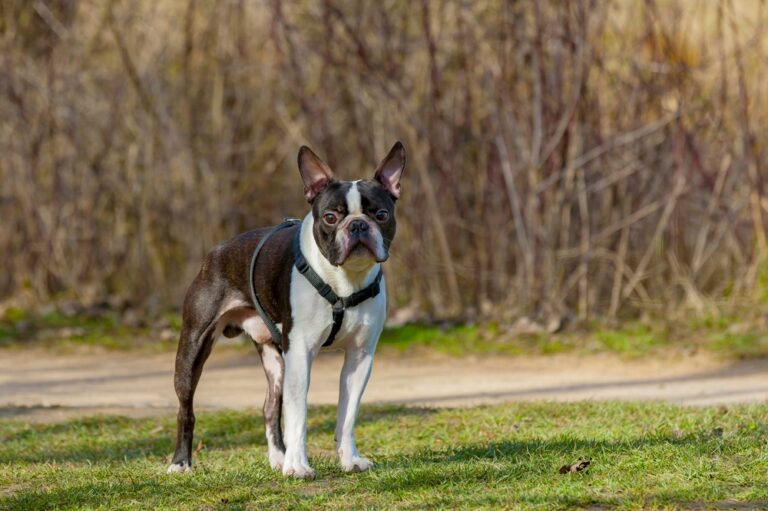- May 18, 2023
Blue French Bulldog: A Comprehensive Guide

Blue French Bulldog are an intriguing and sought-after dog breed known for their distinctive blue coat color. In this blog post, we will delve into the origins and history of French Bulldogs, explore the emergence of the Blue French Bulldog variation, and unravel the genetic factors behind their blue coat color. We will also discuss their physical features, temperament, care requirements, and the reasons why they have become such a beloved breed among dog enthusiasts.
What are Blue French Bulldog?
Blue French Bulldogs are a variation of the French Bulldog breed known for their unique and captivating blue coat color. They are beloved for their charming personalities and distinctive appearance.
While the standard coat colors for French Bulldogs include brindle, fawn, and pied, the blue coat color is a result of a dilution gene that affects the black pigment, resulting in a grayish-blue hue. Blue French Bulldogs have gained popularity among dog enthusiasts for their rarity and exquisite beauty.
1. Origins and History
French Bulldogs have a fascinating historical background. Originally bred as companions for lace workers in England, they later gained popularity in France. From there, they made their way to the United States, where they became cherished pets and eventually developed into a breed of their own. Within the French Bulldog breed, the Blue French Bulldog variation emerged, captivating enthusiasts with its unique coat color.
2. The Alluring Blue Coat Color
The blue coat color is one of the most distinctive features of Blue French Bulldogs. It sets them apart from other French Bulldogs and adds to their allure. We will explore the characteristics of the blue coat color, including the various shades and patterns that can occur. Additionally, we will delve into the genetic inheritance and factors that influence the expression of the blue coat in this breed.
3 Facts About the Blue French Bulldog
1. Origin Misconception
Contrary to their name, French Bulldogs are not actually from France. They originated in England, where they were bred as smaller versions of English Bulldogs. They were later brought to France by lace workers during the Industrial Revolution, and that’s where they gained popularity.
2. Symbol of Status
French Bulldogs have been associated with social status for many years. In the early 20th century, they were favored by the wealthy and fashionable, including notable figures such as the French artist Henri Toulouse-Lautrec. Their compact size, distinctive appearance, and pleasant temperament made them highly sought after as companions.
3. Recessive Gene
The blue coat color in French Bulldogs is caused by a recessive gene. It is a dilution of the black coat color and results in a bluish-gray shade. This unique color variation has gained popularity in recent years, as it sets Blue French Bulldogs apart from other color variations in the breed. However, it’s important to note that the blue coat color does not impact the dog’s health or temperament.
Read Also: Liliac Merle French Bulldog Guide
Things to Know When Owning a Blue French Bulldog
Physical Features and Appearance of Blue French Bulldogs
Blue French Bulldogs are a distinct breed with unique physical features and an eye-catching appearance. In this section, we will describe their overall appearance, physical attributes, and the impact of the blue coat color on their aesthetic appeal.
Overall Appearance:
Blue French Bulldogs are small to medium-sized dogs with a compact and muscular build. They have a solid and sturdy body structure.
They have a distinctive head shape characterized by a square and flat skull. Their face is relatively short, and they have a well-defined stop between the forehead and the muzzle. Their ears are bat-like and stand erect, adding to their charming and expressive facial features.
Blue French Bulldogs have a short and smooth coat that is soft to the touch. They have a straight and dense coat that requires minimal grooming.
Muscular Build:
Despite their small size, Blue French Bulldogs have a well-developed and muscular build. They have a broad chest and a compact body, giving them a robust appearance.
Their muscular build contributes to their agility and overall physical strength. It also adds to their distinctive and charming physique.
Distinctive Facial Features:
Blue French Bulldogs are known for their unique and adorable facial features. They have large, round, and expressive eyes that are usually dark in color. Their eyes are set wide apart and give them a sweet and affectionate expression.
Their nose is usually black, although a blue coat color may sometimes be accompanied by a blue nose. Their nose is short and slightly upturned, which is a characteristic feature of brachycephalic breeds.
Blue French Bulldogs have a wide and strong jaw, with a slightly undershot bite. This gives them their signature “smushed” face and contributes to their lovable and distinctive appearance.
Impact of Blue Coat Color:
The blue coat color is a recessive gene variation found in French Bulldogs. It is a dilution of the black coat color, resulting in a bluish-gray shade. Blue French Bulldogs may have various shades of blue, ranging from light blue to a deeper, steel-like blue.
The blue coat color has gained popularity due to its unique and striking appearance. It sets Blue French Bulldogs apart from other color variations in the breed.
The blue coat color often comes with accompanying traits such as blue or gray noses, and sometimes blue or green eyes. These features contribute to the aesthetic appeal of Blue French Bulldogs and make them even more captivating.
Temperament and Personality Traits of Blue French Bulldog
Blue French Bulldogs have distinct temperament and personality traits that make them beloved companions. In this section, we will discuss the typical characteristics of Blue French Bulldogs, including their affectionate and sociable nature, as well as their adaptability to various living environments.
Affectionate and Loving:
Blue French Bulldogs are known for their affectionate and loving nature. They form strong bonds with their human family members and enjoy spending quality time with them.
They thrive on attention and love to be involved in their owner’s activities. They are often referred to as “lap dogs” because they love to cuddle and be close to their loved ones.
Their affectionate nature makes them excellent family pets, as they get along well with children and are generally gentle and patient with them.
Sociable and Friendly:
Blue French Bulldogs are social animals and enjoy being around people. They are friendly and generally get along well with strangers, making them good candidates for therapy or emotional support dogs.
They are not typically aggressive or overly protective, but they may bark to alert their owners of potential intruders or unfamiliar situations.
Proper socialization from an early age is important to ensure they develop good manners and positive interactions with other animals and people.
Playful and Lively:
Blue French Bulldogs have a playful and lively nature. They enjoy interactive playtime and can be quite entertaining with their antics.
Despite their small size, they have a surprising amount of energy and enthusiasm. Regular exercise and play sessions are essential to keep them physically and mentally stimulated.
They are often described as “clowns” due to their funny and humorous behaviors, which bring joy and laughter to their owners’ lives.
Easygoing and Adaptable:
Blue French Bulldogs are generally easygoing and adaptable to various living environments. They can thrive in apartments or houses, as long as their exercise and mental stimulation needs are met.
They are not overly demanding in terms of exercise and are content with moderate activity levels. This makes them suitable for individuals or families with different lifestyles, including those who may not have a lot of outdoor space.
However, it’s important to note that they are sensitive to extreme temperatures due to their brachycephalic (short-nosed) structure. They may struggle in very hot or cold weather, so precautions should be taken to keep them comfortable.
Read Also: Unveiling the Enigmatic Lilac Fawn French Bulldog
Care and Maintenance of Blue French Bulldog
Blue French Bulldogs require regular care and maintenance to ensure their health and well-being. In this section, we will provide essential guidelines for their care, including dietary needs, feeding practices, exercise requirements, and suitable activities to keep them healthy and happy.
Dietary Needs and Feeding Practices:
- Provide a balanced diet: Blue French Bulldogs, like all dogs, require a balanced and nutritious diet to thrive. Consult with your veterinarian to determine the best diet for your Frenchie, taking into consideration factors such as age, weight, and any specific dietary requirements.
- High-quality dog food: Choose a high-quality dog food that is appropriate for your Blue French Bulldog’s age and size. Look for dog food brands that use natural ingredients and do not contain artificial additives or fillers.
- Controlled portion sizes: It’s important to feed your Blue French Bulldog appropriate portion sizes to prevent obesity. Follow the feeding guidelines provided on the dog food packaging, but keep in mind that individual needs may vary. Monitor your dog’s weight and adjust portion sizes accordingly.
- Regular feeding schedule: Establish a regular feeding schedule for your Blue French Bulldog. This helps regulate their metabolism and prevents overeating. Divide their daily food portion into two or three meals throughout the day.
- Freshwater availability: Always provide fresh and clean water for your Blue French Bulldog. Make sure to refill the water bowl regularly to ensure they stay hydrated.
Exercise Requirements and Suitable Activities:
- Daily exercise: Blue French Bulldogs have moderate exercise requirements. They enjoy daily walks and playtime but are generally not as high-energy as some other breeds. Aim for at least 30 minutes to an hour of exercise per day, split into multiple sessions.
- Brachycephalic considerations: Blue French Bulldogs have a brachycephalic (short-nosed) structure, which can make breathing more challenging for them during intense exercise or in hot weather. Avoid excessive physical exertion in extreme temperatures and watch for signs of overheating or breathing difficulties.
- Interactive playtime: Engage your Blue French Bulldog in interactive play sessions to keep them mentally stimulated and physically active. Toys such as puzzle toys, treat-dispensing toys, and interactive games can help provide mental enrichment and keep them entertained.
- Indoor activities: Blue French Bulldogs can benefit from indoor activities during extreme weather conditions or when outdoor exercise is not feasible. Consider activities like hide-and-seek, indoor fetch, or teaching them new tricks. This helps prevent boredom and keeps them active.
- Supervised socialization: Blue French Bulldogs are social animals and enjoy the company of their human family members. They also generally get along well with other dogs, but proper socialization is essential. Supervise their interactions with other dogs to ensure positive experiences and prevent any potential conflicts.
Health Considerations for Blue French Bulldogs
Blue French Bulldogs, like all dog breeds, have certain health considerations that owners should be aware of. In this section, we will address common health concerns associated with Blue French Bulldogs, highlight the importance of regular veterinary check-ups and preventive care, and provide information on maintaining their overall well-being.
Brachycephalic Syndrome:
Blue French Bulldogs, with their short-nosed structure, are prone to brachycephalic syndrome. This condition can lead to breathing difficulties, especially during physical exertion or in hot weather.
It’s important to monitor their breathing and avoid exposing them to extreme temperatures or situations that may cause stress on their respiratory system.
Regular exercise should be moderate and conducted in cooler environments. Consult with a veterinarian for specific guidance on exercise and temperature management.
Heat Sensitivity:
Blue French Bulldogs are sensitive to heat due to their brachycephalic nature. They can struggle to regulate their body temperature, making them more susceptible to heat exhaustion and heatstroke.
It’s crucial to keep them in a cool and well-ventilated environment, especially during hot weather. Provide access to fresh water and shade when they are outdoors.
Avoid leaving them in a hot car or exposing them to direct sunlight for extended periods.
Allergies:
Blue French Bulldogs can be prone to allergies, which may manifest as skin irritations, itchiness, or digestive issues. Common allergens include certain foods, environmental factors (such as pollen or dust mites), and flea bites.
If you notice any signs of allergies, such as excessive scratching or changes in bowel movements, consult with a veterinarian. They can help identify the cause of the allergy and recommend appropriate treatment or dietary adjustments.
Eye and Ear Issues:
Blue French Bulldogs are more susceptible to eye and ear problems. They may experience issues such as cherry eye (prolapsed third eyelid), dry eye, or ear infections.
Regular cleaning of the eyes and ears can help prevent infections and promote good hygiene. Be gentle and use appropriate products recommended by your veterinarian.
Monitor their eyes for signs of redness, discharge, or irritation, and consult with a veterinarian if any abnormalities are observed.
Dental Health:
Dental hygiene is important for Blue French Bulldogs to prevent dental disease, which can lead to tooth loss and other health issues. Brush their teeth regularly with a dog-friendly toothbrush and toothpaste.
Provide appropriate chew toys or dental treats to help reduce plaque buildup and maintain oral health. Regular veterinary dental check-ups are also recommended.
Regular Veterinary Check-ups and Preventive Care:
Regular veterinary check-ups are crucial for the overall health and well-being of Blue French Bulldogs. These visits allow for early detection and management of any potential health issues.
Vaccinations, parasite prevention (fleas, ticks, and heartworm), and routine blood tests are part of preventive care that should be followed according to your veterinarian’s recommendations.
Spaying or neutering is also commonly recommended, unless breeding is planned under the guidance of a responsible breeder.
| Health Concern | Importance |
|---|---|
| Brachycephalic Syndrome | Monitor breathing and avoid extreme temperatures |
| Heat Sensitivity | Provide a cool environment and avoid heat exposure |
| Allergies | Identify and manage allergens, consult with a vet |
| Eye and Ear Issues | Regular cleaning, monitor for abnormalities |
| Dental Health | Regular brushing, provide dental treats and check-ups |
| Regular Vet Check-ups | Early detection, vaccinations, parasite prevention |
Popularity and Demand
Blue French Bulldogs have experienced a surge in popularity as pets. We will discuss the reasons behind their growing popularity, including their presence on social media and in popular culture. However, we will also touch upon the responsibility of breeders and owners in promoting ethical breeding practices and ensuring the welfare of these beloved companions.
Conclusion
In conclusion, Blue French Bulldogs are truly enchanting creatures that have captured the hearts of dog lovers around the world. Their unique blue coat color sets them apart and adds to their allure.
We have explored their origins, delved into the characteristics of their blue coat, and discussed their physical features, temperament, care requirements, and popularity. Blue French Bulldogs possess a delightful combination of beauty, charm, and affection, making them cherished companions for individuals and families alike.
As with any dog breed, responsible ownership and breeding practices are crucial to ensure the well-being of Blue French Bulldogs. It is important to prioritize their health, provide them with proper care, and seek regular veterinary check-ups to address any potential health concerns. By understanding their unique traits and needs, owners can create a nurturing and fulfilling environment for their Blue French Bulldogs.
FAQs
Q. Are Blue French Bulldogs more prone to health problems?
A. While Blue French Bulldogs are generally healthy, they can be more prone to certain health issues. It’s important for owners to be aware of these potential concerns and take proactive measures to maintain their dog’s well-being. Regular veterinary check-ups and a balanced lifestyle are crucial in keeping them healthy.
Q. Can the blue coat color be passed on to offspring?
A. Yes, the blue coat color can be passed on to offspring if both parents carry the recessive gene for the blue coat. Breeders carefully manage breeding programs to ensure the health and genetic diversity of Blue French Bulldogs.
Q. Are Blue French Bulldogs suitable for families with children?
A. Yes, Blue French Bulldogs can be great companions for families with children. They have a friendly and sociable temperament, making them well-suited for family environments. However, supervision and proper introductions between children and dogs should always be practiced to ensure a safe and harmonious relationship.
Q. How can I find a reputable breeder for a Blue French Bulldog?
A. When looking for a Blue French Bulldog, it’s essential to find a reputable and ethical breeder. Research local breeders, visit their facilities, and ask for references. Reputable breeders prioritize the health and well-being of their dogs and are transparent about the breed’s potential health concerns. They will also provide proper documentation, health guarantees, and support throughout the dog’s life.
Tags
What do you think?
Related Articles

New Puppy Checklist: Gear You’ll Need for Your New Dog
Getting a new puppy is really exciting, but before you welcome them home, it’s important to prepare your space for them. Since puppies need a

How Big Do Mini Poodles Get? Vet Reviewed Average Weight & Growth Chart – Dogster
The information is current and up-to-date in accordance with the latest veterinarian research. Learn more » When you buy a Miniature Poodle, you might not

Can Police Dogs Smell Nicotine? Vet Verified Facts & Info – Dogster
The information is current and up-to-date in accordance with the latest veterinarian research. Learn more » While cigarette sales have been declining steadily for decades,

How Old Is 5 in Dog Years? Vet-Approved Guide to Each Size of Dog – Dogster
The information is current and up-to-date in accordance with the latest veterinarian research. Learn more » A common method for calculating a dog’s age is

